#Kaysersberg
Explore tagged Tumblr posts
Text

Kaysersberg, France
955 notes
·
View notes
Text

Street scene in Kaysersberg, Alsace region of France
French vintage postcard
#scene#france#alsace#postkaart#photo#vintage#postkarte#postal#postcard#photography#briefkaart#tarjeta#carte postale#region#ansichtskarte#french#historic#sepia#street#ephemera#kaysersberg
15 notes
·
View notes
Text
Best Places to Visit in Alsace, France
One of my French friends recently got married, and her wedding was the perfect excuse to explore the region of Alsace on our long weekend. Here are the best spots to eat, to see and to have dessert (duh).
I have spent the majority of my years in France in the south, under the sun, by the sea. And when I’d venture up north, it was oftentimes to Paris for a weekend or work trip. Outside of Paris, I have yet to explore much of the northern half of France. But recently, I was invited to wedding in Alsace, a famed French region nestled next to Germany and an area known for its wine, beautiful villages…

View On WordPress
2 notes
·
View notes
Text
A light walk near Kaysersberg
Today was a loop walk from Kaysersberg up into the hills and back.
These are nice because you can adjust the walk if you want to. I headed out. The first couple of miles were on lightly used roads and then unpaved forest tracks. Those are great for me, not too steep and not too rocky.
My hotel is just outside the town gate and below the ruins of the old castle.
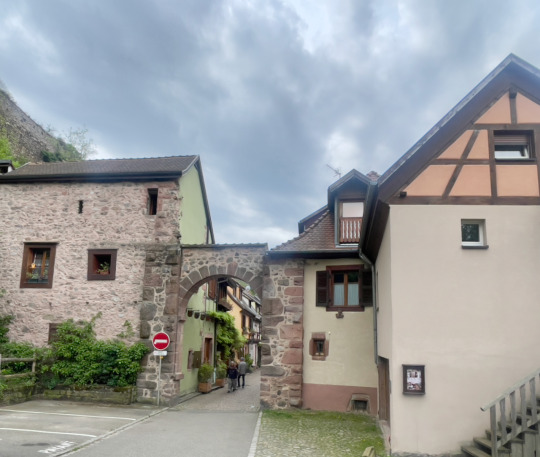
As you can see, it was very cloudy with rain forecast for the afternoon.
The road went out through the suburban residential areas. They are very nice, with lots of flowers and trees.

Then it went up into the woods. Lots of tall trees on the hillsides through here.

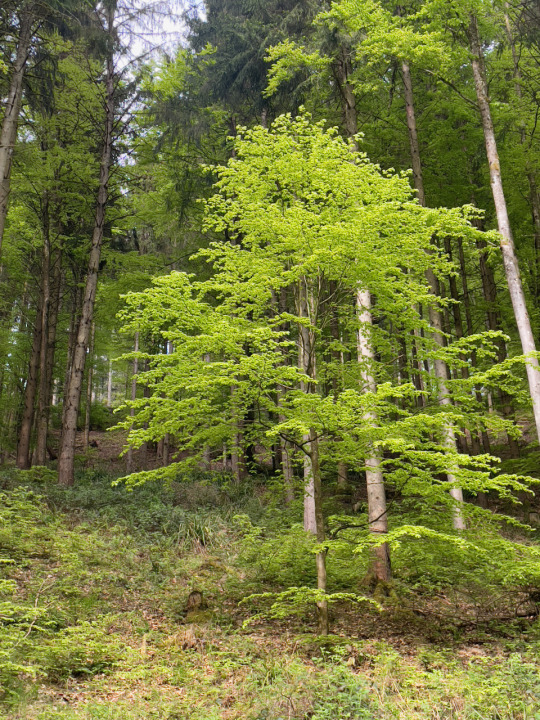
While I have walked a lot in the woods, I haven't seen much wildlife. There may have been a deer yesterday, going up a hill very fast through the woods, but I just got a glimpse. There are supposed to be squirrels but I haven't seen any of them. (How can there be so many oak trees and no squirrels? It was the same last fall. The ground was covered with acorns and not a squirrel in sight.)
So here is my big wildlife sighting.

There was a caution sign for batraciens. I doubt they are big enough to do much damage if you hit one though. I despite the image on the sign I had to look up batraciens. It translates to Batracians. So I had to look that up. It's amphibians, of a certain class. The frog class I'm guessing. But a frog is a grenouille, so I really don't know. I also didn't see any.
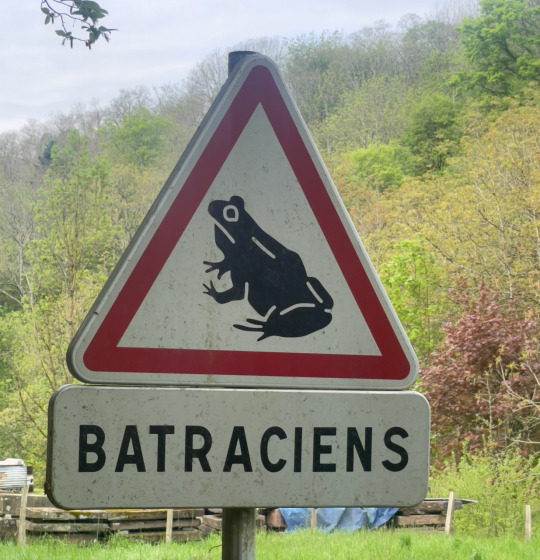
When the trail turned to "steep and rocky" I headed back to town.
In town, the flowers are blooming.
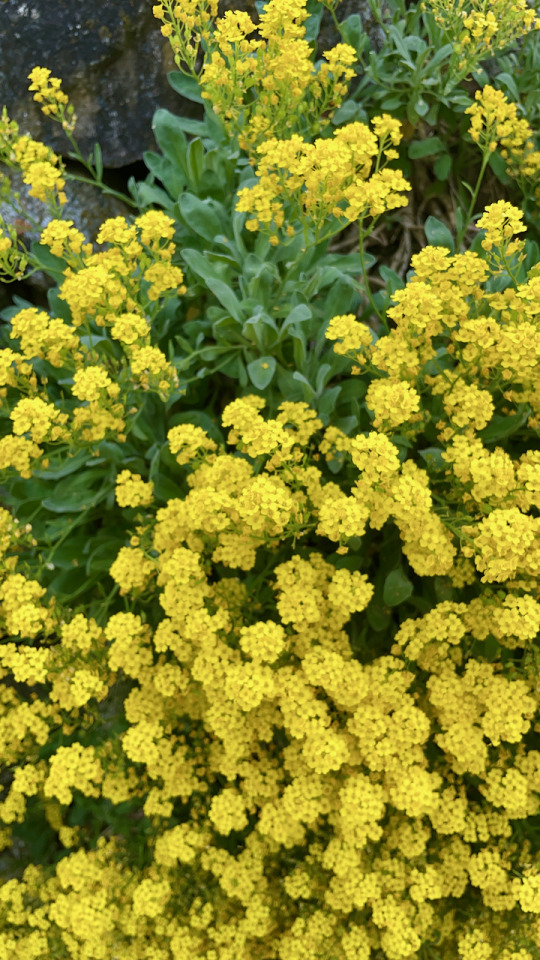
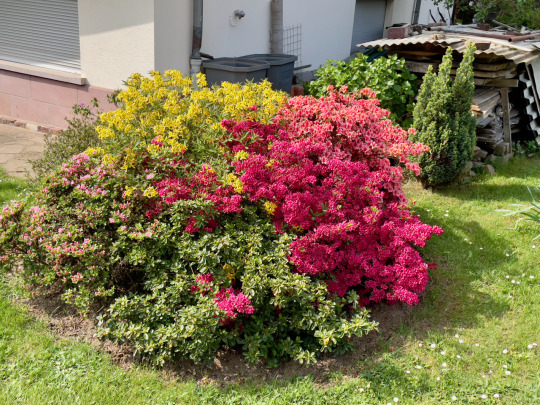

I got back to town in time to have some lunch and get back to the hotel before the thunderstorm!
So a pleasant, easy day; only about 5 miles and 800 feet.
Tomorrow it's on to Bergheim, with my hotel at the end of the hike, so no slouching tomorrow.
1 note
·
View note
Photo

Kaysersberg / France (by didier david).
1K notes
·
View notes
Text

Werewolf attack, woodcut from Kaysersberg's Die Emeis (1517)
5 notes
·
View notes
Text
Riquewihr and Kaysersberg
Today was utterly lovely. Strasbourg is snug up against the French/German border and the mix of cultures is obvious everywhere. We decided to rent a car at the train station and journey a bit south where Switzerland gets involved. We picked up the keys (they gave us a BMW suv for the price of a compact!) and drove through more beautiful countryside.



Aha! JUst what we were looking for- Riquewihr! The enchanting village that inspired Beauty and the Beast. We drove through vineyard after vineyard and found our way to the magical spot.



Cobblestones, medieval buildings, and old wells and fountains down every street.







The Alsace region is home to a large population of storks. The legend of storks bringing babies started here. Children who want a baby brother or sister leave a sugar cube on their windowsill hoping to lure a baby-carrying stork. So there are stork souvenirs everywhere, and as sweet as the legend is, I don't need stork hot pads, magnets, coffee cups, or statues. BUT, another symbol that appears everywhere that i just love is...

hearts! They're all over the place. These late blooming geraniums on the front of a crackled 15th century building are accompanied by a trio of sweet hearts.


Window boxes, shutters, curtains, fences - even cookies and pastries were heart-shaped. It put a smile on my face.
After a few hours wandering around beautiful Riquewihr we decided to ease on down the road. Again, over the river and through the vineyards we go. Pardon my photography, these were taken through the windshield.


This time we were looking for Kaysersberg, and we found it! I liked it even more than Riquewihr.









We roamed and roamed, eventually stopping for a late lunch.
I had a delicious quiche and a salad. The mister chose another tarte flambe. He's hooked.

After satisfying our tummies, we continued to explore and uncover more information about Kaysersberg. "The name is German for Emperor's Mountain. The high fortress that dominates the town serves as a reminder of both its strategic importance and its warlike past." The town was first mentioned in 1227, when Frederick II, Holy Roman Emperor purchased the castle and began to refortify it. During the Middle Ages, Kaysersberg prospered. In 1648, the city became a part of France, although most inhabitants continued to speak German. From 1871 to 1918 (and again from 1940 to 1944) Kaysersberg belonged to Germany. It's now part of France again and lucky for us, still so very beautiful. Before we turned the car back toward Strasbourg we decided to gather the ingredients for a yummy charcuterie dinner in our apartment. We scored cheese and sausage in this shop.

Nuts and sweets in here,

and even found a bag of delicious local grapes. Oh my, what a feast we had tonight! Is there anything better after a long day than snacking in your pajamas? Anyway, that's it from me tonight. I should have given you a bit more info on Riquewihr, and I'll probably do a bit of a summary of this trip when we get home. But I'm pooped and I took wayyyy too many pictures to wade through tonight. Tomorrow is a light schedule. We'll get up whenever we get up, walk to train station and hop on a train going to Colmar. We've read good things and would like to see it for ourselves. It's a quick 30 minute train ride which leaves us the bulk of the day to wander. Trains between Colmar and Strasbourg run all day so we can return as we please. Isn't that a nice, hassle-free day? Exactly what a vacation should be. Until tomorrow, dear pals. Stay safe, stay well. XOXO, Nancy
5 notes
·
View notes
Text

Kaysersberg s'illumine 🥨
2 notes
·
View notes
Photo
100 years ago:


Kaysersberg, France (by TablinumCarlson)
#historic#monument#photography#vintage#sepia#france#photo#briefkaart#french#ansichtskarte#postcard#patrimoine#elsass#postkarte#postkaart#carte postale#europe#ephemera#years#postal#100 years ago#kaysersberg#tarjeta#alsace#architecture
1K notes
·
View notes
Text

View of Kaysersberg, Alsace region of France
French vintage postcard
#postcard#ansichtskarte#briefkaart#france#photography#carte postale#vintage#postkarte#photo#historic#postkaart#ephemera#sepia#view#alsace#region#french#tarjeta#postal#kaysersberg
7 notes
·
View notes
Text




Le Haut-Rhin. (2) (3) (4) by Murielle Danieli
Via Flickr:
(1) Les berges de la Thur. / The banks of the Thur. (2) Le pêcheur à la mouche. / The fly fisherman. Kaysersberg. (3) Le couple de Colvert. / The mallard couple. (4) L’Ecomusée d’Alsace à Ungersheim, dans le Haut-Rhin, est le plus grand musée plein air de France où ont été transférées et remontées d’authentiques constructions alsaciennes formant comme un village : maisons à colombages, maisons d’ouvriers, boutique, mairie, tour fortifiée ( la photo), halle des fêtes, ferme, école, lavoir, jardins, champs. Dans ces constructions généralement anciennes et ouvertes au public, sont présentés les travaux traditionnels de la région ainsi que l’artisanat. The Ecomusée d'Alsace in Ungersheim, in Haut-Rhin, is the largest open-air museum in France where authentic Alsatian constructions forming a village have been transferred and reassembled: half-timbered houses, workers' houses, shops, town hall, fortified tower (photo), village hall, farm, school, wash house, gardens, fields. In these generally old buildings and open to the public, traditional works of the region as well as crafts are presented.
3 notes
·
View notes
Text
Kayserberg to Bergheim
The distance from Kayserberg to Bergheim was apparently a little far and there were no good routes. So the program was for the taxi that moves the baggage to move me to the start of the hike in Riquewihr, which is another nice little village. The first thing I noticed in town was several shops specializing in macaroons. So I bought a little bag, way smaller than the ones these guys bought. .

The route went right through the center of town, of course.



Then it was out into the vineyards. The main part of the route was pretty flat today, skirting the edges of the hills.


Soon, off in the distance, I could see the three castles of Ribeauville up on the hills.

I don't understand the three castles in one place thinking, but it seems like it was the thing to do.

Then the route went down into Ribeauville, yet another quaint town.



At this point, I had a choice to make: hike up to the castles and back down or have a nice lunch in a restaurant. I went for lunch. I have seen a lot of ruined castles over the years.
I had a small serving of veal cordon bleu with the local Munster cheese. It was still too much food and they were disappointed that I skipped the appetizer, cheese course, and dessert.
Then it was through town and back on the road to Bergheim, also pretty flat.




Up ahead on the furthest hill another castle. This one was restored in the early 1900's, but is off the walking route and would require a taxi.

Then it was into Bergheim, my home for the next two nights.

It had been a pleasant, easy walk today.
0 notes
Text




Kaysersberg en Alsace en France. Photo par moi.📸💖
Kaysersberg in Alsace in France. Photo by me.
3 notes
·
View notes


